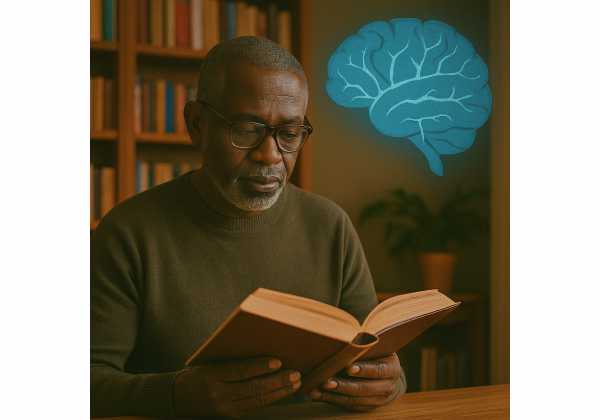
Learning is one of the few levers that continues to pay dividends across the lifespan. You can’t change the brain you were born with, but you can change how effectively your brain uses what it has. That adaptability—called “cognitive reserve”—helps preserve function even when age or illness adds wear and tear. This article translates the science into practical steps: choosing the right challenges, structuring practice, balancing the four language-like modes of skill, making it social, measuring what actually matters, and turning it all into a calendar you’ll keep. If you’re building a broader plan for sustained attention, memory, and mental agility, see our concise brain longevity guide. Then come back here to design learning that sticks.
Table of Contents
- What Cognitive Reserve Is and Why It Protects Function
- Novelty and Challenge: Choosing the Right Level of Difficulty
- Structured Learning: Courses, Certifications, and Groups
- Mixing Domains: Art, Tech, Language, and Logic
- Make It Social: Clubs, Teams, and Mentorship
- Measure What Matters: Effort, Satisfaction, and Stickiness
- Design a Yearly Learning Calendar You’ll Keep
What Cognitive Reserve Is and Why It Protects Function
“Cognitive reserve” describes how flexibly the brain can recruit networks to solve problems when its hardware is under strain. Two people can have similar levels of age-related change or even disease, yet differ greatly in how they think, plan, remember, and function. The gap often reflects years of mentally demanding activity that trained the brain to work around obstacles. Reserve isn’t about having more tissue; that’s “brain reserve.” Nor is it just about keeping tissue healthy; that’s “brain maintenance.” Cognitive reserve is the playbook and the teamwork—efficient routes, backup plans, and coordination across regions—built through learning and engagement.
Why this matters for longevity: reserve helps preserve everyday function (managing money, navigating new technology, organizing tasks) despite typical aging. Observational and meta-analytic data suggest that higher reserve, accumulated at any life stage, is associated with a lower risk of dementia diagnosis later on. Early-life education, midlife occupational complexity, and late-life cognitive and social engagement all contribute. The magnitudes vary by study, but the direction is consistent: more cumulative engagement, lower risk. Even in later life, increased participation in mentally active pursuits—learning to code, taking adult education classes, advancing a craft—has been linked with better trajectories.
Reserve is built by three ingredients:
- Intensity: meaningful effort that nudges you past comfort into focused concentration.
- Variety: challenges that use different cognitive tools (memory, problem solving, planning, spatial reasoning).
- Continuity: repeated exposure over months and years, with periodic consolidation and review.
Learning changes structure and function. Practice can strengthen white matter pathways, increase efficiency within networks that support attention and executive control, and improve the ability to switch strategies when the first plan fails. Think of reserve as “transferable problem-solving.” You learn Spanish, but you also get better at focusing in noise, juggling competing demands, and catching errors. Those capacities travel.
Crucially, reserve is not an emergency fix; it’s an insurance policy. You don’t have to “win” at every task. You do have to keep engaging—selecting goals that matter enough to show up for, calibrating difficulty so that you struggle productively, and measuring progress in ways that reinforce the habit. The rest of this guide turns that philosophy into practice.
Novelty and Challenge: Choosing the Right Level of Difficulty
Reserve grows fastest in the zone where tasks are new enough to require fresh strategies but not so hard that you disengage. Too easy, and you’re coasting; too hard, and you’re overwhelmed. Aim for “just-manageable difficulty”: frequent small errors, quick feedback, and visible improvement across sessions.
A four-step way to calibrate:
- Pick a compelling target. Choose something you care about beyond “brain training”: conversational Mandarin for travel, building a small app, reading sheet music, or solving geometry problems to coach a grandchild. The practical payoff sustains effort when motivation dips.
- Set a 30–60 day challenge block. For the first month or two, define a tangible outcome (e.g., deliver a three-minute talk, publish a small project on GitHub, perform a simple duet). That timeframe is long enough to see adaptation, short enough to be specific.
- Adjust in-session load. When success feels automatic, raise stakes: increase speed, reduce cues, add a live audience, or combine with a secondary task (e.g., speaking while pacing or playing to a metronome). When you hit a wall, step back one notch—not ten.
- Review weekly for friction. Ask: Where did I hesitate? What tripped me? Which mistakes keep repeating? Use those answers to plan next week’s drills.
Picking the “right hard”:
- Comprehension strain: Choose materials that force you to slow down—slightly above your current level.
- Memory strain: Practice recall without prompts before checking notes; alternate between retrieval (no notes) and re-study (focused fixes).
- Executive strain: Add constraints that demand planning (time limits, step ordering, “explain it to a beginner”).
Common traps and fixes:
- Trap: starting five new skills at once. Fix: choose one anchor skill and two micro-skills.
- Trap: confusing novelty with randomness. Fix: keep a thread of continuity—one topic, multiple forms.
- Trap: chasing badges instead of ability. Fix: tie rewards to real performance (e.g., three uninterrupted minutes of fluent conversation).
When your schedule is tight, microbursts (8–12 minutes) count if they include retrieval and feedback. And if you want to time training with periods of heightened adaptability, scan our companion piece on midlife learning biology (learning windows) to align expectations with physiology.
Structured Learning: Courses, Certifications, and Groups
Self-guided learning is flexible, but structure multiplies follow-through. Courses, certifications, and group programs provide sequence, stakes, peers, and feedback—the ingredients that convert interest into skill.
How to choose a program that builds reserve (not just trivia):
- Project-first design: Favor courses where each module builds toward a public output: a performance, a portfolio artifact, a presentation, or a working prototype. Outputs force integration across memory, attention, planning, and error correction.
- Active testing: Look for frequent low-stakes quizzes, labs, and live drills. Retrieval practice (recalling without notes) strengthens durable traces more than passive review.
- Spaced schedules: Sessions that revisit core ideas over weeks beat cram-style sprints. Check the syllabus for revisiting cycles and cumulative assessments.
- Varied modes: Good programs blend short lectures, guided practice, and peer teaching. Teaching others is a potent generator of transfer.
- Feedback quality: You need precise, prompt error signals. Prefer instructors who give annotated critiques, rubrics, or code reviews over simple pass/fail checks.
Certification: when it helps and when it doesn’t.
Industry certifications and language proficiency exams can sharpen focus by specifying competencies and holding you to a date. They also provide clear performance anchors (e.g., A2 → B1 in 6–9 months with 90–150 hours). But if a credential pushes you toward rote drills or cramming, you may gain a badge and lose momentum. Ask: Will this exam force me to integrate skills I want long-term?
Cost-savvy options:
- Community colleges and adult education programs often deliver excellent instruction at low cost.
- MOOCs can work if you add accountability: join the course’s study forum, form a small peer pod, or commit to periodic check-ins with a mentor.
- Local makerspaces and arts centers provide hands-on pathways (woodworking, ceramics, electronics) where feedback is immediate and mistakes are instructive.
A simple scaffolding template:
- Week 1–2: orientation and foundational drills; write a personal learning contract (why this skill, what output, what schedule).
- Week 3–6: progressive challenges; publish small milestones weekly.
- Week 7–8: consolidation; remove supports (notes, slow tempo, extra time).
- Week 9–10: performance window; record, present, ship.
For choosing skill domains that stretch multiple systems—perception, planning, motor sequences—scan our piece on complex, project-based practice (project-based practice) to ensure your syllabus emphasizes doing, not just knowing.
Mixing Domains: Art, Tech, Language, and Logic
Cross-training the brain works like cross-training the body: you reduce plateaus and broaden the capacities you can call on under pressure. Mixing domains creates productive interference—skills learned in one area force your mind to reconfigure in another, strengthening flexible control.
A balanced “learning plate” might include:
- A language or symbol system (Spanish, Python, music notation). These build working memory, sequencing, and error monitoring.
- A craft (ceramics, woodworking, photography). Crafts demand sensorimotor coordination, spatial reasoning, and patience with iteration.
- An analytic practice (logic puzzles, statistics, chess). Analysis hones planning depth and inhibitory control.
- A performing art (singing, improvisation, acting). Live performance trains attention under stress and resilience after mistakes.
You can rotate emphasis each quarter while maintaining a light touch on the others. For example, focus on conversational language this season (four sessions/week), keep a weekly craft class, solve logic problems on weekends, and sing with a community group twice a month. This simple shift in time allocation prevents monotony without scattering effort.
Why this blend helps reserve:
- Multiple bottlenecks: Different domains stress distinct limits (auditory discrimination vs spatial planning vs rule abstraction), compelling your brain to recruit alternate routes when the primary one falters.
- Transfer of control skills: Self-monitoring, chunking, self-pacing, and error recovery generalize across activities. You notice a hesitation pattern in scales that mirrors your coding bugs: slow down before the tricky bar/line, preview, then run cleanly.
- Emotional buffering: When progress stalls in one area, wins in another preserve motivation and identity (“I’m a learner”)—vital for continuity.
A weekly mixing pattern to try:
- 2 days: Primary skill (deep practice blocks + retrieval drill).
- 2 days: Complementary skill (motor-heavy or performance-based).
- 1 day: Analytic tune-up (puzzles, strategy games, short proofs).
- 1 day: Review and plan (log metrics, adjust goals, schedule).
- 1 day: Restorative engagement (nature sketching, mindful listening).
Music deserves a special mention: rhythm and melody synchronize attention, timing, and movement in ways that benefit learning across the board. If you’re curious about how rhythm and practice shape memory and mood, see our overview of music-based learning to pick an instrument or approach that suits your goals.
Make It Social: Clubs, Teams, and Mentorship
Human brains are social brains. Social learning increases stickiness through accountability, emotion, and shared problem-solving. It also recruits additional circuits—language, perspective-taking, turn-taking—that reinforce executive control and resilience.
Where to find your people:
- Conversation groups and exchanges: Libraries, cultural centers, and community colleges host language tables, book circles, and film clubs. Rotate roles—moderator, note-taker, summarizer—to practice different skills.
- Project teams: Join a local hack night, makerspace build, or arts collaborative. Projects create deadlines and shared definitions of “done.”
- Mentorship circles: Pair up across skill levels. Mentors learn by explaining; mentees learn by simplifying questions. Both gain structure.
- Performance communities: Choirs, theater troupes, debate clubs, and storytelling groups combine rehearsal with spotlight moments that train focus under pressure.
Make social learning effective:
- Define the ask. Before a session, decide what feedback you want (clarity, technique, timing).
- Keep stakes high but safe. Adopt a “kind, specific, helpful” feedback rule.
- Plan for error. Expect to stumble live. Practice recovery phrases (“Let me restate that,” “Once more from bar 12”).
- Contribute at your edge. Volunteer for roles that stretch you without breaking confidence.
Social connection also protects health broadly. It reduces isolation, which can sap motivation and energy for learning. If you want targeted strategies to strengthen relationships alongside skill-building, see our guide to social connection tactics and bring a friend into your learning plan.
Create your own micro-community in two hours:
- Pick a theme (e.g., “10-week beginner film club” or “Saturday morning sketch walk”).
- Set time, place, and a simple rule set (on time, devices off, feedback protocol).
- Post a call in neighborhood groups or at the library.
- Start with three people; consistency matters more than size.
- Celebrate a clear finale (public share, mini-showcase, short recital).
Learning is easier to sustain when someone expects you to show up—and when you want to show up because the room is warm, challenging, and fun.
Measure What Matters: Effort, Satisfaction, and Stickiness
Most people track inputs (“I studied for an hour”) and grades (“I passed”). Reserve cares about different metrics: sustained effort at the right difficulty, enjoyment that drives repetition, and memory traces that stick when you come back days later. Measure like a coach, not a registrar.
Three categories to log weekly:
- Effort (leading indicators): number of focused sessions; minutes of retrieval (no notes); proportion of time in deliberate practice vs passive consumption; average challenge rating (1–5).
- Satisfaction (motivational fuel): a brief post-session mood check; one sentence on what felt better than last time; one friction note.
- Stickiness (retention and transfer): cold-start performance after 48–72 hours without practice; ability to do the skill in a new context (talk with a stranger; code without the template; perform at a different tempo).
A lightweight learning log template:
- Plan (Mon): 3 goals; specific drills; two short retrieval sessions.
- Do (Tue–Fri): record sessions (time, drill, challenge rating).
- Review (Sat): re-test cold; write a two-line debrief (“What stuck? What didn’t?”).
- Adjust (Sun): scale difficulty; tweak schedule; set next week’s mini-milestones.
Quality checks that actually predict progress:
- Error distribution: Are mistakes shrinking or merely moving? If they move, adjust the drill.
- Latency to flow: How quickly do you enter deep focus? Shortening ramp-up time suggests better preparation and cues.
- Recovery speed: After a stumble, how fast do you return to baseline? Practice fast resets.
- Generalization: Can you teach a three-minute mini-lesson? Teaching exposes gaps—and cements mastery.
Pair cognitive metrics with simple physical signals. Learning draws on energy and arousal; sleep, light movement, and breaks shape outcomes. For ideas on tracking movement patterns that correlate with attention and processing speed, see our primer on movement signals and how they interact with cognitive effort.
Finally, celebrate “boring” wins: finishing a week at your planned volume; returning after a miss without drama; repeating a drill cleanly three times. Reserve grows from the ordinary dose done consistently—not from occasional heroic sprints.
Design a Yearly Learning Calendar You’ll Keep
A calendar makes the difference between good intentions and a body of work. Design yours for durability: realistic volume, clear cycles, and deliberate rest. The goal is not to cram more into your life; it’s to let the right activities recur so often that your brain starts to expect them.
Build in seasons, not streaks.
- Quarterly focus: Choose one anchor skill per quarter (language, instrument, programming, drawing). Hold it steady for 12–13 weeks.
- Monthly theme: Layer a rotating micro-skill (pronunciation; scales; data visualization; perspective).
- Weekly cadence: Set two deep practice blocks (60–90 minutes), two micro-sessions (10–15 minutes), and one social or performance slot.
- Recovery week: Every seven to eight weeks, reduce volume by ~40% and consolidate (test recall, clean up notes, perform one small piece).
Budget time and friction.
- Time anchors: Attach sessions to stable cues—after breakfast on Tues/Thu, or immediately on arriving at the library Saturday morning.
- Environment reset: Keep your tools ready (instrument tuned, IDE configured, sketch kit packed). If setup exceeds two minutes, you’ll defer.
- Friction ledger: Track what repeatedly eats time (passwords, travel, noisy rooms). Solve one friction per week; small upgrades add up.
Integrate life events.
- Trips become labs: Learn the local script; schedule a photo walk; attend a neighborhood class.
- Holidays become showcases: Play or present for family; record a year-in-review video.
- Service deepens learning: Tutor students, translate materials, volunteer tech support for a nonprofit, sketch for a community event.
A four-quadrant sanity check: Draw a box with axes for meaning and difficulty. Fill each quadrant with candidate activities. You want most of your calendar in “high meaning, moderate difficulty”—with a sprinkling of “high meaning, high difficulty” to keep growth alive. Avoid “low meaning, high difficulty” tasks unless they’re short bridges to higher-meaning work.
Protect the habit:
- Miss once; never twice. Reset immediately with a micro-session.
- Keep a “rainy day” list of tiny drills (five lines of code; one page of reading aloud; two scale patterns).
- End sessions by planning the next starting action (“Open chapter 4; review examples 1–3; set metronome to 66”).
At year’s end, create a simple portfolio: a playlist, a repo, a photo album, a sketchbook spread. Seeing tangible progress sustains identity—“I’m someone who learns”—which, more than any tip or trick, is what builds lifelong cognitive reserve.
References
- A framework for concepts of reserve and resilience in aging — 2023 (Guideline/Consensus)
- Cognitive reserve over the life course and risk of dementia: a systematic review and meta-analysis — 2024 (Systematic Review)
- Lifestyle Enrichment in Later Life and Its Association With Dementia Risk — 2023 (Cohort Study)
- Bilingualism as a Contributor to Cognitive Reserve — 2022 (Review)
- The Effects of Combined Cognitive-Physical Interventions on Cognitive Functioning in Healthy Older Adults: A Systematic Review and Multilevel Meta-Analysis — 2022 (Systematic Review)
Disclaimer
This article is for educational purposes and does not replace personalized medical advice. Learning plans should be tailored to your goals, health status, and schedule. If you have concerns about memory, mood, attention, or neurological symptoms, consult a qualified clinician for evaluation and guidance.
If you found this helpful, please consider sharing it on Facebook, X, or your favorite platform, and follow us for future articles. Your support helps us continue creating clear, trustworthy guides to brain health and lifelong learning.










